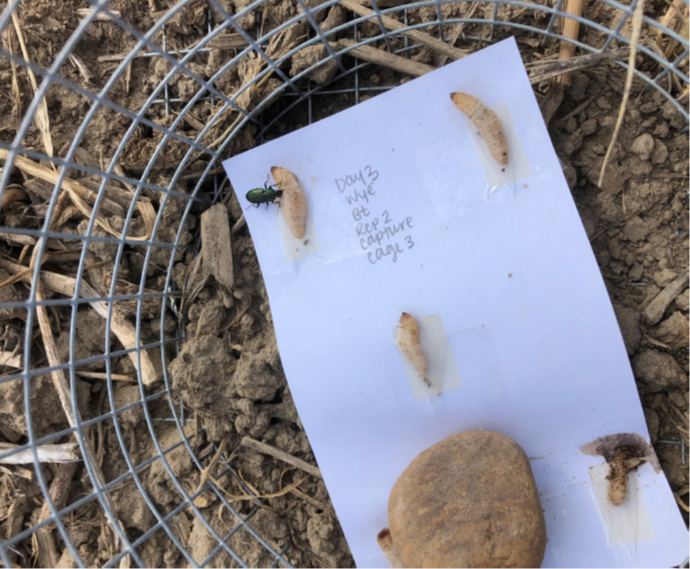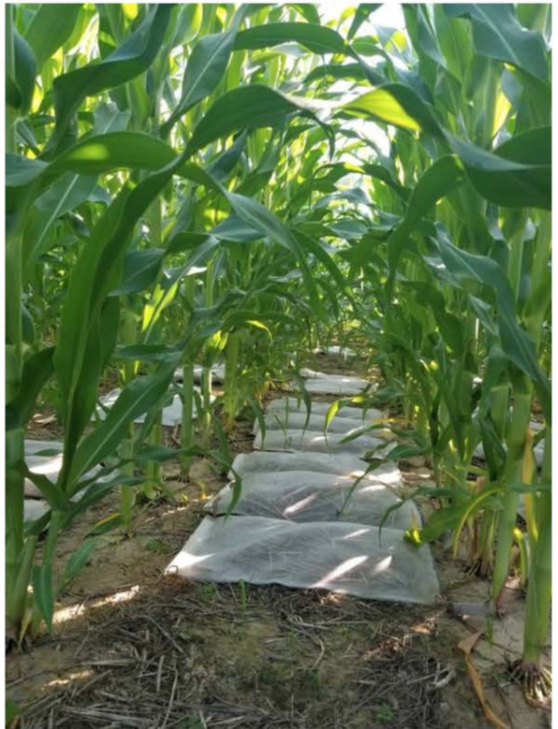'Roots in Research' Newsletter
CMREC - Beltsville Facility - Yield Year 2023
The 2023 growing season can be summed up in a single word: “dry.” Changes in rainfall patterns and hot, dry summers are just one of the stresses that MD farmers can expect to face under a changing climate. Many of the research projects carried out at the UMD RECs are helping to find solutions to help farmers cope with drought stress and other climate change factors. From genetic improvements to crops and alternative crop rotations, to cover crop management and climate monitoring, the studies carried out at our RECs are designed to ensure the success of MD agriculture through adaptive and resilient cropping strategies. Enjoy this summary highlighting the hard work that UMD researchers are doing in pursuit of solutions to agriculture’s most pressing problems. Cover photo credit: Nathan Hepp
Alan Leslie
MAES Center Director
WMREC | CMREC | LESREC
 To view this newsletter electronically, scan the QR code!
To view this newsletter electronically, scan the QR code!
Download PDF of Roots in Research _________________________________________________________________________________________________________________________________
Beltsville Weather Station
Weather data for Beltsville is displayed on our website. The information can be displayed by month, or by the year in a printable format. To compare weather data averages by the month or year, check out our website! If your research requires this data in a different format, please contact Sheila Oscar and he will help to get the information you are requesting.
____________________________________________________________________________________________________________________
Effect of Planting Date on Seasonal Timing of Pest Complexes and Insecticide Efficacy
Kelly Hamby, Associate Professor and Extension Specialist, Department of Entomology
Lasair ní Chochlain, M.S. Student, Department of Entomology

LeafByte mobile app was used to measure soybean leaf defoliation. To better understand when insect pest pressure threatens full season soybean production, the impact of planting date on the overlap between pest pressure and vulnerable soybean growth stages, and the efficacy of tank mixing an insecticide with a postemergence herbicide application, we conducted a two year study in two fields at CMREC Beltsville and WyeREC. Soybeans were planted as early as possible (around May 1) and one month later and treated with herbicide alone just before canopy closure or herbicide plus Warrior II (lambda-cyhalothrin, 1.92 fl oz/acre) insecticide. Pest pressure, damage, soybean growth, and yield were compared throughout the growing season. Planting in May improved yield in one site year; however, the earlier planting also usually experienced a bit heavier pest pressure. Pest pressure was typically below economic threshold levels and the insecticide application never improved yield.
We would like to thank the Maryland Soybean Board for their support of this project.
__________________________________________________________________________________________________________________

____________________________________________________________________________________________________________________
Optimizing Early Season Pest Management for Maryland Field Corn
Kelly Hamby, Associate Professor and Extension Specialist, Department of Entomology
Maria Cramer, Ph.D. Candidate, Department of Entomology
Field corn insect pest management decisions begin before planting, including selecting hybrids with or without different plant incorporated protectants and/or insecticide seed treatments. At planting, in-furrow insecticides can also be used. These products vary in their efficacy and residual control as well as impacts to beneficial natural enemies that feed upon pests. In addition, they redundantly target many of the same sporadic early season insect pests while potentially not controlling others. We compared pest management efficacy and pest pressure between an untreated control (bare seed), Poncho® 250 (clothianidin 0.25 mg/ seed) treated seed, and an in-furrow application of Capture LFR® (bifenthrin 13.6 fl oz/acre.) This experiment was conducted in both a Bt hybrid with a plant incorporated trait package for above ground caterpillars and a non-Bt hybrid, with three replicate plots of each treatment at three farms over three years. Poncho more consistently reduced insect damage than Capture (which did reduce insect damage in non-Bt corn) and also improved stand. However, neither insecticide improved yield even in the one year and location where wireworms were controlled. To better understand their impact on natural enemies, particularly carabid ground beetles that may feed upon slugs, we also compared carabid beetle and slug abundance. In addition, we measured natural enemy feeding activity (predation) by placing sentinel caterpillars in the field overnight and evaluating how many were killed. Predatory carabid beetles commonly occurred and predation ranged from 0-100% across individual sentinel prey cards, with around 16% of the caterpillars killed on average. The insecticide treatments did not impact slugs captured in shelter traps, slug damage, carabid beetle abundance, or amount of predation (caterpillars killed overnight). Ultimately, untreated non-Bt corn yield well at all sites and years of our experiment and the pest pressure we observed did not reach treatment thresholds. Using foliar insecticides to target specific issues as they reach levels of economic concern more effectively and economically controls insect pests.
For more results and details see our Agronomy News Article https://blog.umd.edu/agronomynews/2023/11/28/optimizing-early-season-pest-management-for-maryland-field-corn/
We would also like to thank the Maryland Grain Producers and Utilization Board for providing funding for this work.
__________________________________________________________________________________________________________________
Severe Defoliation of Vegetative Maize Plants Does Not Reduce Grain Yield: Further Implications with Action Thresholds
Carlos A. Blanco , Gerardo Hernandez , Kevin Conover , Galen P. Dively, Urbano Nava-Camberos , Maribel Portilla , Craig A. Abel , Paul Williams, and William D. Hutchison
Abstract. It is commonly perceived that early defoliation of maize (Zea mays L.) is a significant risk for maximum grain yields. However, several studies designed to assess biotic and abiotic factors that reduce leaf area reported contrasting results. When maize suffers defoliation before developing its seventh leaf (V7 stage), plants can often compensate without impacting grain production. Seventy-five percent of 20 reviewed publications that offer empirical information indicated severe defoliation did not affect maize yield when plants were less than V7. We present field results for six maize hybrids, lines, and a landrace with severe (75%) defoliation one, two, or three times before reaching V7, in Maryland. Results showed that despite...Read more>>>
___________________________________________________________________________________________________________________
Sweet Corn Sentinel Monitoring Network: 2023 Results and Trends
Galen P. Dively, Department of Entomology, University of Maryland, et al.
Starting in 2017, the sweet corn sentinel monitoring network has been tracking changes in corn earworm (CEW) susceptibility to Cry and Vip3A toxins expressed in Bt corn and cotton. Each year, Syngenta and Bayer-Seminis provided sweet corn seed that is repackaged and distributed to volunteer collaborators to establish sentinel plantings of Bt hybrids (expressing Cry1Ab, Cry1A.105+Cry2Ab2, and Cry1Ab and Vip3A) planted side by side with non-Bt isolines. All collaborators used the same sampling and data collection protocol to generate metrics showing differences in control efficacy between Bt and non-Bt plots, expressed as the percentage of ears damaged, density of surviving larvae per ear, and the amount of kernel area consumed per ear. Read more>>>
__________________________________________________________________________________________________________________
UMD Bee Lab and the New UMD Bee Squad
https://www.umdbeelab.com/ https://umdbeesquad.com/
The Honey Bee Lab at the University of Maryland has diverse personnel with multidisciplinary scientific backgrounds who bring a fresh perspective to solving problems. Research in the laboratory is focused on an epidemiological approach to honey bee health. We are proud to share our research into the major mechanisms that are responsible for recurring high loss levels in honey bee populations, such as pests and pathogens associated with honey bees, loss of natural forage habitat due to large monocultural croplands, and pressure from human induced changes in the environment.
Our team has led and managed the USDA APHIS National Honey Bee Disease Survey since 2009. We are also a major partner and founding member of the Bee Informed Partnership (BIP), who collaborates closely with beekeepers from across the country to study and better understand the loss in honey bee colonies in the United States.
You can find Realtime results about these efforts at our database portals: https://research.beeinformed.org/state_reports/. Click here to purchase UMD Honey
Donations If you are able to help support our mission to improve honey bee health, we greatly appreciate whatever you can give. You may donate online using the University of Maryland "Giving to Maryland" Honey Bee Lab Donation Site. Thank you for your support!
__________________________________________________________________________________________________________________
Enhanced Cover Cropping for Nutrient Management - Two Fields
Ray Weil, Professor of Soil Science
Below are two videos showing no-till planting into a typical rye cover crop terminated in mid-April, 3 weeks before planting compared to an enhanced cover cropping practice of "planting Green" into a much bigger living multi-species green cover crop.
The enhanced cover crop promises to fight climate change and improve soil health by sequestering 4-5 times as carbon from the atmosphere into the soil, as well as reducing fertilizer needs by fixing 50 to 100 lbs of nitrogen per acre.
Click here to view video 1 and video 2
____________________________________________________________________________________________________________________
Fundamentals of Soil Science Course - Catena in the Field
Eni Baballari - Environmental Science and Technology, University of Maryland

Every semester, students of ENST200, Fundamentals of Soil Science, take the drive to the Central Maryland Research and Education Center (CMREC) - Beltsville Facility to study soils in the field.
During this field trip, curious students of soils use augers to dig deep into the many layers of soil, called horizons. They get soil from four different locations, representative of the local topography. They deposit their diggings into a trough and come together with their soil troughs from four locations to see them side-by-side and discuss differences between them. They talk about the 5 soil formation factors (parent material, climate, organisms, topography, and time) and how each of these has influenced the local soil. Importantly, they also talk about the influence that soil properties have on the land use capabilities, such as farming or installation of a septic tank field.
Students love this trip and we look forward to continuing to showcase the wonder of soil!
__________________________________________________________________________________________________________________
Impact of Cover Crop Termination Method on Soil Moisture and Temperature
CMREC – Beltsville Field Experiment 2022-2023
Cara Peterson, Ph.D. Candidate
Dr. Kate Tully, Associate Professor, Agroecology Lab, Department of Plant Sciences and Landscape Architecture
Dr. Steven Mirsky, Research Ecologist
Sustainable Agricultural Systems Laboratory, Agricultural Research Service, USDA To prepare for spring planting, farmers rely on mechanical (e.g., roller-crimping, mowing, tilling) and chemical methods to terminate their winter cover covers. Most growers using cover crops in conventional grain production systems terminate their cover crops in the spring by spraying broad spectrum post-emergent herbicides. Additionally, farmers in both conventional and organic production systems might roller-crimp their winter cover crop, effectively flattening the cover crop biomass into a mulch layer. Recent research has focused on herbicide selection and roller-crimper timing for effective cover crop termination, however there is limited knowledge about the impact of these choices on spring soil moisture dynamics and cover crop residue decomposition. Read more>>>
____________________________________________________________________________________________________________________
